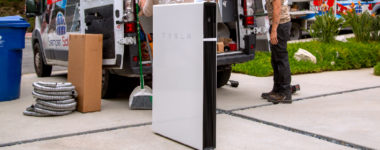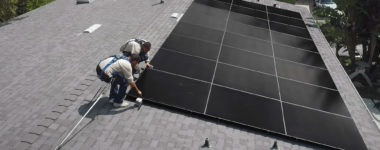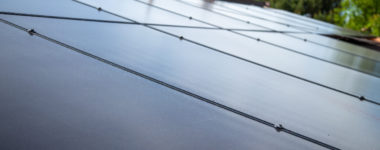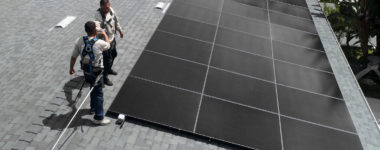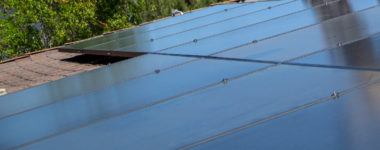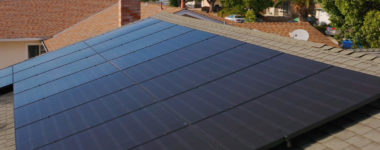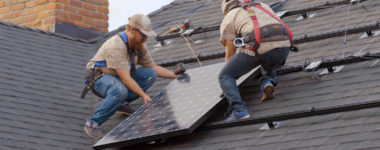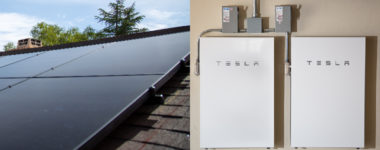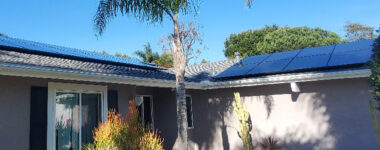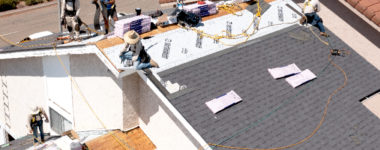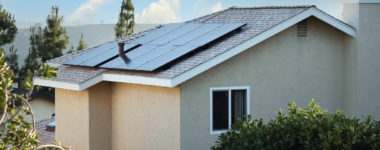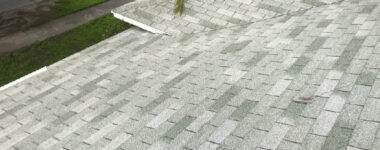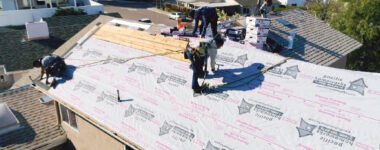Semper Solaris Blog
Several years ago, Elon Musk steered Tesla Motors into the renewable energy market with an innovative home energy storage product – Tesla Powerwall. This home battery is designed with the same dedication to detail and innovation as Tesla’s cutting-edge electric vehicles and other ventures. While Tesla certainly didn’t invent solar storage batteries, they certainly used their reputation as a leading-edge tech and renewable energy-conscious company to launch their Powerwall into a mostly untapped market. With Tesla’s stamp of approval, new buzz and interest have surrounded the prospect of storing solar energy created by a home’s solar panels. So what exactly is the Powerwall? According to Tesla, it is a small-scale rechargeable lithium ion battery that provides homeowners with more access to self-sustaining energy for their homes Understanding Tesla Powerwall These batteries are designed for optimal use with a solar panel system. How does having the Powerwall installed change the game for homeowners with solar panels? It gives them much more independence from the grid when it comes to energy needs during low production times. Essentially, the Powerwall allows a homeowner to fully control their electricity production and usage by storing home energy for later use. As would be expected, Tesla spent a significant amount of time and energy developing the Powerwall into a reliable, effective home battery for regular use. The battery works by storing any excess electricity your solar panels produce vs. allowing that electricity to be sent back to the grid (usually for a credit in most states). Even in states with a credit, homeowners are still technically “buying” electricity from the grid when their panels don’t produce electricity at certain times. The battery allows any surplus to be stored and used during these times rather than grid dependency. While a single Powerwall battery won’t enable you to go completely “off the grid,” it does allow you much more freedom and starts to transition your home towards being much more self-sufficient. How Long Will Tesla Powerwall Last? Tesla backs it Powerwall up with a completely unlimited 10-year warranty. This warranty covers daily charging and usage, so essentially as much wear and tear as possible. The warranty also guarantees that a home’s Powerwall will maintain a minimum of 70% of its full charge capacity over this time. It is typical for batteries to lose some of their ability to maintain a charge with usage. Is Tesla Powerwall Right for Your Home? Adding a solar battery to a home solar panel system isn’t right for everyone. Further, solar batteries are still pretty new to the market, meaning the technology will continue to improve with time. If you have a utility system that provides net metering for solar panel owners, a solar battery may not be as necessary. In comparison, homeowners in areas that enforce time-of-use rates for electricity would be wise to consider investing in a solar battery to curb their expenses. Finding out if a solar battery is a good investment for your home starts with talking to a solar expert. Semper Solaris is a Tesla Powerwall certified installer and can answer any questions you have about Tesla Powerwall or similar solar energy batteries.
As solar energy becomes a more popular renewable energy source, switching becomes more and more attractive to homeowners. There are numerous factors to weigh, especially the cost of investing in solar panels compared to the rising cost of electricity. Any type of change can be somewhat intimidating at first. You may be wondering if switching to solar power would be too much of a hassle or if the panels will even last long enough to make the switch worth it. If you need a little motivation to push you over to the solar side, Semper Solaris is here to help. Top Motivations for Going Solar Promotes a Healthier Environment The earth is full of precious resources that people have been harvesting and using for countless years. However, other resources -- such as certain fossil fuels -- have been causing serious damage to the environment. The health of our environment should far outweigh the benefits of fossil fuels – which is why solar energy has gained significant popularity in the last few decades. The more homes and businesses that switch to solar, the less our world is reliant on more harmful fossil fuels. Instead of being dependent on fossil fuels, a switch to primarily solar can significantly cut back on greenhouse gas emissions. Not only that, but studies have found that if solar energy was adopted on a wider scale, various respiratory problems could be lessened as well. For example, the National Renewable Energy Laboratory found that an increase in solar energy usage vs. fossil fuels would cut back on harmful emissions that can sometimes result in bronchitis, respiratory issues, and even cardiovascular problems. Solar Helps Boost the Economy There is no denying that the market for solar is booming. In fact, the International Renewable Energy Agency reported that solar employment has grown 17 times faster than the rest of the country’s economy. More than 250,000 people were employed in the solar industry in 2017, with numbers expected to continue to grow. Gives You Back Control of Your Utility Bills Having to stress over the rise and fall of electricity costs can be stressful. You have to monitor and track your use, be conservative with your usage at times that may be convenient, and ultimately, don’t have any control over the prices you are charged. The good news? Switching to solar energy gives you back control. With a solar panel system, you are able to convert the sun’s rays into usable energy for all your household needs. Another positive? In most areas, any excess electricity created will go to the grid and be credited back to you, which means during the evening or on cloudy days, you still have your electricity needs covered. These are just a few of the most compelling reasons to switch to solar, so if you’d like to learn more about going solar, our solar panel experts can provide insight.
While there are plenty of energy options available to consumers, solar energy is emerging as one of the most effective. Energy harnessed from the sun’s rays is unique in that it is essentially “clean,” providing homeowners, schools, businesses, and all types of facilities with a renewable source of energy. California is one of the leaders in solar power production. In fact, it is leading the nation in number of projects installed, currently sitting at 842,977. California Legislature has even proposed that all of the state’s electricity resources come from renewable energy by 2045. What does this mean for homeowners considering their energy options? As solar power continues to become a priority for California, the incentive to switch to solar grows more and more. Fossil Fuels vs. Solar Energy So what about the old, still heavily used energy source, fossil fuel? Most commonly, fossil fuels refer to natural gas, coal, and oil. Collectively, these fossil fuels have accounted for a majority of the earth’s energy usage. Drilling for these natural resources can be costly and damaging to the earth’s surface, water sources, and more. Not only that, but we are coming dangerously close to depleting many of our main sources of fuels. That means either investing a significant amount of time and money mining for additional resources or finding a new source of energy. At the end of the day, no matter how useful we’ve found fossil fuels in the past, society cannot ignore the fact that fossil fuels create serious pollution. Fossil fuels are not renewable and take much longer to form vs. the rate we are using them. What exactly does the pollution problem look like? Around 21.3 billion tons of CO2 every year, which is considered to be a global warming contributor by scientists. Solar Changes the Energy Game Solar power is changing the game though. By converting sunlight into electricity through solar panel systems, people all over California (and the country) have access to a much cleaner source of energy. But how do we get the equipment to harvest the sun’s power? It is true that solar panels are manufactured using some fossil fuels at this point, however, it is a very minimal amount compared to utilizing fossil fuels for all electricity needs. As PV panel prices continue to drop and more innovation drives the way solar panels are manufactured, the process will get much cleaner. Not only that, but the financial advantages of switching to primarily renewable energy (both wind and solar) significantly outweigh the expense of harvesting and using fossil fuels in the long-run. In comparison with other renewable energy sources, solar power is the most accessible for homeowners. Panels can affordably be installed based on a family’s budget, home size, and overall electricity needs. This means a clean earth has never been more accessible and affordable to our modern world. So why wait? Find out how you can make the switch to solar today. Contact Semper Solaris to learn more about our team and our solar options.
Have you ever heard the phrase, “You need to spend money to make money.”? That’s all well and good… as long as you have the money to spend! Take solar panels for your home as an example. Solar panels can help you dramatically lower or even eliminate your monthly energy bills, but what if you can’t afford the hefty price tag? Then it’s time to consider a solar lease. This financing option is extremely popular with homeowners throughout California because a solar lease offers you a viable way to get solar panels with little or even no money down. In this article, we’ll take a look at solar leases work and answer all of your burning solar lease questions. What Is a Solar Lease? Many of us don’t have thousands or tens of thousands of dollars sitting in our savings account that we can spend on a new solar power system. Likewise, you may be wary of taking on a solar loan to pay for your system or refinancing your house to scrounge up the money. A solar lease can be an excellent way still obtain solar panels without handing over your life’s savings. A solar lease is a financing option that lets you essentially “rent” your solar panels from a solar leasing company for a set cost each month. (A car lease works essentially the same way.) The solar leasing company owns the panels and all the equipment and shoulders the full cost of installing, maintaining, and monitoring your system. A solar lease is an ideal choice if you don’t want to pay out-of-pocket for your solar panels. It’s also an excellent way for you to support renewable energy production and lower your carbon footprint. How Much Will My Solar Lease Cost? Every solar lease company offers different lease terms, but most provide zero-down payment options, meaning that you can lease your solar panel system without an upfront payment. Certain solar leases do require a small down payment, so make sure you review the terms of your solar lease carefully before signing the agreement. The actual monthly cost of your solar system will depend on a variety of factors, including the size of your solar system, the type of solar panels that make up the system, and labor costs in your geographic area. Will a Solar Lease Save Me Money? That’s the idea! Your solar lease provider will charge you a set rate each month based upon an estimate on how much energy your solar panel system will generate. Typically, solar lease clients enjoy a savings of between 10% and 30% each month on their energy costs. The beauty of a solar lease is that your savings are likely to increase over time. As the utility companies continue to raise their rates, you’ll save more and more compared to your neighbors who don’t have solar panels. How Long Does a Solar Lease Last? Your solar lease will be active for a set amount of time as defined in your solar lease agreement. Typically, these agreements last between 20 and 25 years. Again, a solar lease allows you to pay the same set rate each month for all the energy your system produces. Over 25 years, utility costs are almost guaranteed to rise significantly, leading to even bigger cost savings for you! What Happens If My Solar Panels Break? One of the things that make solar leases so convenient is that the solar leasing company owns your solar panel system and is responsible for continually maintaining and monitoring the system. In the rare instance that your solar panels break, or their performance drops, your solar leasing company will come out and fix the issue. You won’t have to pay out-of-pocket to replace your solar panels or to hire a repair team. Will My Solar System Cover All My Energy Needs? Ideally, if you are working with an experienced and high-quality solar panel company, your solar installer will accurately assess your home’s energy usage and recommend a system that covers your energy needs. That being said, your energy usage will fluctuate from month-to-month. For example, when the sizzling summer months roll around, you’ll probably want to switch on your energy-guzzling air conditioning. Your solar lease payment only covers the energy your solar panels produce. If you use more energy than your system generates, you’ll need to get the rest of your energy from your public utility provider and will be charged their rates. This is an important factor to understand and to consider as you plan your solar lease system. Energy usage changes over time in most households. For example, if you purchase an electric car in the future, your energy needs could quickly outpace what your panels produce. The same is true if your kids come back from college or a parent moves into your home. On the flip side, if your kids will be heading out on their own in a few years, you may want to consider leasing a system that is a little smaller than your current, kid-juiced energy usage rates would indicate. What Is the Difference Between Solar Leases and Power Purchase Agreements? As you research solar leases, you may come across the term “Power Purchase Agreement” (PPA) or see solar leases and PPAs used interchangeably. PPAs are very similar to solar leases, but they operate in a slightly different way. With a solar lease, you “rent” your solar panel system and all the power it generates for a set monthly fee. With a power purchase agreement, you pay a set fee for every kWh (kilowatt hour) the system produces. Your monthly payment will vary depending on how much energy your system creates. For example, in winter, you may pay less, since longer nights mean less sunlight your system can convert into energy. In summer, your PPA payment will be higher as your panels drink in all that extra sunlight. Can I Still Get Renewable Energy Incentives if I Lease? Depending on where you live, homeowners in your area who invest in solar panels may qualify for local rebates or other tax incentives. One of the biggest incentives is the federal tax deduction, which allows you to deduct 26% of the cost of your solar panel system from your tax bill. Unfortunately, all of these incentives go to the owner of the solar panel system. If you choose a solar lease, these incentives will go to the solar leasing company, not to you. Remember though, that the solar leasing company is paying for the panels, the equipment, and the installation. Renewable energy incentives allow them to offer you low lease rates and no-money-down financing options. Can I Purchase My Solar Panels? Most solar leases will allow you to purchase your solar panel system during the lease period or when the lease expires. You may have to pay a predefined price as laid out in the lease agreement or the fair market value of the system (usually whichever amount is higher). Purchasing your solar panel system may be a good idea if your income increases over time and you would rather eliminate your energy costs altogether rather than pay the set lease rate each month. What Happens If I Want to Sell My House? As you’ve learned in this article, a solar lease typically lasts between 20 and 25 years. That’s a long time. Considering that the average American stays in their home for 13 years, chances are more likely than not that you’ll move out of your house before your lease expires. In this situation, you have two options. You can choose to purchase the solar panel system outright and include it in the price of your home. The second option is to transfer the remainder of the lease to the new homeowners. Your solar leasing company has handled this issue plenty of times and can work with you and the new homeowner to transfer the lease. Unfortunately, if the home buyer does not want to take on the lease, you may face a steep financial penalty if you need to break your lease. In this situation, it may be a better idea to simply purchase the system and include it in the sales price of your home. What Happens at the End of My Solar Lease? Maybe you are currently living in your dream home and plan to stick it out into your golden years. In this case, you may wonder what happens when your solar lease comes to an end. At that point, you’ll have a few options on how to deal with the solar panels on your roof. You could simply choose to renew your lease, though your terms and payment rate may change. If you’re done with leasing, you can decline to renew the lease, and the leasing company will come out and remove your solar panel system. Your final option is to purchase the system. It is worth speaking with a solar installation company to determine if purchasing your current system is a good idea. Solar technology continues to improve at a rapid pace even as prices continue to drop. In 20 years, it may actually be a better deal to purchase a brand new solar panel system! Should I Buy Solar Panels for My Home or a Solar Lease? It’s important to carefully weigh the benefits and the drawbacks of solar leasing before you make a final decision. Leasing is the most cost-effective option in the short term. You can get solar panels on your roof with little or no money down and begin saving on your monthly energy bills immediately. Solar leasing is also convenient. You don’t have to worry about installation, maintaining the system, or monitoring it. You’ll also get one reliable lease bill each month for the duration of your agreement. However, if you want the most savings over time, it’s probably a better idea to purchase solar panels for your home. You’ll have to pay a big chunk of money out of pocket, but your system will significantly lower or even entirely eliminate your monthly energy bill. You’ll also get to take advantage of the federal tax deduction and any local tax incentives and rebates available, which can help lower the overall cost of your system. Most studies find that solar panel systems in California will pay for themselves in six to seven years. After that point, your solar panels will be keeping money in your pocket while you protect the environment. Not sure whether to purchase your solar panels or go with a solar lease? Talk to a local solar installation company to learn more about the pros and cons of each option. At Semper Solaris, you can contact us today to schedule a free energy analysis, and we’ll send a trained solar representative to your home to walk you through your financing options.
Semper Solaris is proud to be one of the top solar installers in Southern California. The demand for solar panel systems has never been greater; however, that also means the demand for information and insight on solar energy is also in high demand. We understand that homeowners have lots of questions before diving into the solar energy world – ranging from how much panels cost to how they actually work – which is why we strive to provide all the info they need to make informed decisions. Fact #1: Solar Energy Is Free & Abundant Coming from the powerful rays of the sun, solar energy is a free resource available across the globe. The only costs come from actually harvesting the power of the sun, such as manufacturing, installing, and maintaining a solar panel system. Even still, the fact that the sun is readily available to produce solar energy throughout the day is a reassuring fact in light of the depleting nature of fossil fuels. Fact #2: Solar Is Growing to a Favored Energy Source Solar energy has many advantages and long-term benefits for the planet as a whole. Due to its minimal impact, solar is considered one of the most popular renewable energy sources. Because of this, solar has grown to be a leading renewable energy source, with states like California pushing to be completely renewable energy dependent in less than 30 years. Fact #3: Solar Is a Non-Polluting Energy Source Not only is solar energy considered one of the top sources of renewable energy, but it also counteracts the Greenhouse effect on the earth’s climate. The recent global warming issue is thought to be caused greatly by human’s significant use of fossil fuels. In fact, solar energy doesn’t produce any pollution, which means it doesn’t harm the environment like other energy sources do. While there are other renewable energy sources on the market, solar energy is one of the most broadly accepted and used as technology continues to be developed for converting solar energy into electricity. Fact #4: Solar Panels Are Basically Maintenance Free Unlike other home applications, solar panels require little to no maintenance, making them a hassle-free energy source. Solar panels convert power and send it to batteries that don’t need any service or tune-ups, allowing them to last for years with minimal work. Further, once a homeowner has had their solar panels installed and paid for, there are basically no recurring expenses. Fact #5: The Price of Going Solar Is Becoming More Affordable When solar energy was first introduced, it was used by limited groups. Now, countless homeowners across the country have solar panels installed on top of their homes, allowing them to harvest the power of the sun on a daily basis. As the technology continues to improve and advancements are made in the conversion and storage of renewable energy, the cost of having solar panels installed will continue to become more attainable for homeowners and business owners alike. Solar also helps cut down expenses for homeowners, reducing electricity bills and giving them more control.
Ever wonder how long solar panels are meant to last? Sure, getting unlimited power from the sun sounds great, but what if the solar panel system built to harness and convert this “free” power breaks down? Many homeowners interested in solar are hesitant when it comes to going solar because they want to weigh the cost of investing in solar to the actual benefits. One of the many benefits? Solar panels have proven to be extremely reliable over the years. What About Harsh Weather & Other Issues? It is true that solar panels are more likely to “fail” sooner in harsher conditions, such as extreme heat or humidity, hail, wind, or other elements. While this isn’t a major threat and the rates only increase slightly in these regions, it is something to be considered and acknowledged. Of course, any outdoor component of your home is in danger of weather damage; however, just like other materials, solar panels are built to last these conditions as best as possible. Other common causes of solar panel failure can include manufacturing defects, installation errors; however, these are normally considered “outlier” cases rather than normal issues. Solar Panels Are Built to Last Don’t just take our word for it – studies have shown that solar panels are extremely reliable. According to a recent report published by the National Renewable Energy Laboratory (NREL) – which is part of the U.S. Department of Energy – an average of only 5 out of every 10,000 panels failed on a yearly basis. The study looked at more than 54,000 photovoltaic panel systems installed over a 10-year period, finding that a median of just .05% of all the panels installed had to be replaced or failed. Additionally, panel failure rates have only improved over the last few decades as solar panel technology improves. With solar panels becoming more resilient and reliable than ever, homeowners who switch to solar now can be confident in their investment. To add even further peace of mind, most high-quality solar panels are backed by extensive warranties to ensure homeowners are protected from any defects, unexpected failures, or really any potential failure. These warranties can range anywhere from 10 years on the low end to 25+ years on the high end. For homeowners, that means even if an unexpected or unlikely panel failure did occur, most likely they would be covered by the panel manufacturer, resulting in a free panel replacement. Take the Next Step Towards Going Solar When you break it down, modern solar panels are becoming all the more reliable, efficient, and effective. What more can you ask for from a renewable energy source? Reach out to Semper Solaris today to get your free energy analysis.
Going solar is not just a popular trend — as of 2020, California is requiring most new home builds to include solar panels (also called PV panels). Solar creates jobs, uses clean energy, and saves homeowners big time on their long-term costs. Semper Solaris is also inviting veterans to become a part of our workforce — a whopping 11.1% of people working in solar are veterans! But how much are solar panels really worth to homeowners who will have to install their own systems after they move in? As it turns out, quite a lot! We’ll look into finding out how installing PV panels on your home will not only increase your property value, but pay for itself by way of monthly energy savings and additional income. Solar Panels and Home Value The addition of solar panels tends to add significant value to a home. At least one study from the Lawrence Berkeley National Lab (LBL) shows that you don’t even have to live in a bright southwestern state to reap financial rewards from solar panels. In California, homeowners will see about a $4 increase for every watt of solar power installed, but homes in other states still see a $3/watt increase in value on average. To put it another way, a homeowner in California can instantly increase their home equity by $20,000 by putting in 5,000 watts of solar power. You may also increase the value of your home by leasing a solar panel system rather than buying, though not all buyers will want to take on a lease responsibility. But does this value really last? If you’re in your forever home it’s normal to be concerned that the immediate value of your solar panels will wear off only to be replaced by high maintenance costs, or that within a few years your solar panels won’t harness the same amount of energy. The news is good in this department, too. Over the life of your homeownership, EnergySage estimates that you can save about $20,000 over the course of 20 years with just energy savings alone. Combined that will the surge in your home’s value, and you can realize a big return even if you don’t sell your home soon while the PV panels are brand new. Lifespan of a Solar Panel But, how long will your solar panels last? If you live in your home for 25 years, should you expect them to go kaput? While the average warranty on a solar panel is 20 years -- that doesn’t mean their life expectancy is exactly two decades. According to a meta-analysis of solar studies conducted by The National Renewable Energy Laboratory, solar panels may be effective for far longer than previously thought. Most estimates of PV panels predicted that after 20 years, solar panels would still produce 80% of the energy that they did in the beginning. What the analysis by NREL found was that this figure is wrong -- which is actually promising for homeowners. PV panels have been performing well beyond expectations! In fact, the degradation rate for PV panels is just 0.4% per year for panels manufactured after 2000 (and only 0.5% for older panels) and not the 1% per year that had been assumed. What that means is that after 20 years, you can expect your solar panels to operate at 92% of the original power. The improved degradation rate figure benefits you in a few ways. First, it increases the value for you as a long-term homeowner. You will continue to enjoy lower utility costs for many years. Slow degradation also means that when you sell your home you can promise the future owner -- in good conscience -- that the PV panels will continue to yield financial benefit. Selling Energy to Local Grids The value of your PV panels lies not just in an increase in home value and reduced utility bills, but also in their potential for earning you a monthly check from your energy company. If you’re in one of the 40 states that allow net metering, you could earn a monthly check by sending your unused energy credits back to the utility company. How does this work exactly? Your PV panels collect energy from the sun, even when your lights are all off and you’re not at home. If you use other energy saving techniques, such as energy efficient appliances, it’s unlikely that you’ll be able to use all of the energy your panels capture. The solar energy is stored on the local energy grid, and you draw from it each time you start using power. Solar power is stored and utilized in kilowatt-hours (kWh) units. You’re only billed for your net energy use. That is, you’re not billed for the gross amount of energy that is generated at by your panels using the regional grid, only what you actually use. This scheme typically results in 20-40% of your energy being sent to the grid -- and you’ll be financially compensated. Excess energy is used by the utility company for other customers. Net metering payments have no expiration period. Meaning an energy company won’t stop buying back your energy units once the PV panels reach a certain age or once you’ve maxed out on a finite number of kWh. Even after a few years, you can continue to take advantage of net metering so long as it remains legal in your area. Selling Solar Panels If you decide you don’t want to keep your PV panels you can sell them so long as you own the panels and are not leasing. Just as if you were selling a used appliance or hot water heater, you will likely sell the panels at a reduced cost. Some companies specialize in purchasing used PV panels, or you can advertise your panels and accept the best honor. Their worth will depend on how much power they continue to generate and their general condition. Keeping up with regular maintenance, such as proper cleaning that avoids scratching the panels while removing smog residue or other dirt. How Much are Solar Panels Worth in the End? Deciding whether solar panels are a good investment for your home depends on myriad factors. They are typically a good financial decision, and they allow you to reap the benefits of energy independence. As you weight whether to get PV panels installed at home, here are some things to consider: Does your state allow you to use net metering and make money by selling back your energy? In California, you are able to use net metering if your system’s peak output is 1,000 kW or less. You must apply and receive approval from your utility company to take advantage of net metering. How long will you be in your home? If you’re only having solar panels installed to increase the home’s value, you won’t realize as great a financial return as if you stay in the home and reduce utility costs over the course of many years. Do you have tax incentives available for installing solar panels and other green energy initiatives at home? The federal investment tax credit (ITC) lets you deduct 30% of the cost of solar installation from your taxes the following year. Some states also offer additional incentives for going solar. Is your roof ideal for solar panels? You may want to consider a roof replacement if the current tiles are not in good condition. If your roof is heavily shaded by trees, consider trimming them back to allow more direct sunlight onto the PV panels. How much are solar panels worth in the long haul? Given their potential to improve your home’s resale value and the ability to slash your energy costs, they can be worth quite a lot. Aside from their financial benefit, solar panels are also worth a lot in regards to improving your way of life. Installing PV panels at home is an investment that frees you from dependence on fossil fuels and reduces your negative footprint on the environment. You’re also helping to create jobs in one of the most promising energy markets in the world! If you’re ready to get serious about adding solar panels to your home, it’s time to schedule a free energy analysis with Semper Solaris! There’s no pressure and we’ll never send you any spam. Contact us today for more information.
“The solar industry is booming.” That’s according to the Solar Energy Industries Association (SEIA), which found that the solar industry has grown by an average annual rate of 59% over the last ten years. The rise in solar installation has spurred the appearance of many different solar installers, including large, national chains. If you’re in the market for solar panels, you have more solar installation companies to choose from than ever before. With so many options, you may be wondering, “Do I really need to choose from solar providers near me?” It’s tempting to work with a national solar installation chain for several reasons. These huge companies have plenty of money for slick advertising and also offer competitive pricing. You may even run into their friendly representatives at Costco or Home Depot. However, by choosing a national corporation instead of a local solar installer, you may be shortchanging your community, your wallet, and the integrity of your solar panel system! Here are five big reasons that the answer to the question, “Do I need to choose from solar providers near me?” should be YES! Local Companies Understand Your Roof Your city and neighborhood has a unique character and architectural history. It’s important that any contractor who works on your home possesses a deep understanding of the design standards and common building materials of your area. A local solar installation company will have plenty of experience working on the types of roofs that are common in your city. This is important because the installers need to know how to work on your roof without damaging it and how to correctly install the racking that attaches to your roof and holds the solar panels in place. It makes a big difference if your roof is made from clay tiles, asphalt shingles, rubber slate, or metal. Understanding your roofing structure is especially important if you need to replace your roof before installing solar panels. Some solar companies (including Semper Solaris) also offer roof replacement services. A roof is much more than just tiles or shingles on top of your house. It is a complex system that requires an in-depth knowledge of local materials and local roof styles. Your roof protects your home and can help make your house much more energy efficient. Don’t trust it to a big, national company that doesn’t understand local roof styles and hasn’t worked extensively with the roof materials that are common to your area. Local Companies Know the Local Law Every state, county, city, and town has its own local ordinances, including specific building and safety standards that contractors must meet when making changes to residential homes. Local solar installation companies are very familiar with all these local building requirements. They are pros at submitting paperwork, pulling the correct permits, and setting up final inspections once a solar power system has been installed. They also know how to work with local homeowners associations to get projects approved. In fact, a local solar installation company may already have experience working with your HOA. You can’t put a price on this knowledge. Local companies can save lots of time and headaches just by knowing the lay of the land. On the other hand, a national company will have to figure all of the local rules and building codes out from scratch. This increases the chances of delay, or worse, and error. A national company may overlook needed paperwork or fail to pull the correct permit, which could endanger your entire project! Local Companies Can Help You Get Renewal Energy Incentives Cities all across California offer homeowners valuable incentives to invest in solar. However, these incentives are only available to homeowners in the know… or, more accurately, to solar installers who know how to obtain them. For example, Los Angeles currently offers homeowners a one-time rebate of $0.25 per watt on their new solar panel installation. Depending on the size of your solar panel system, you could receive a rebate check in the mail worth thousands of dollars! However, the steps to qualify for the rebate aren’t easy. It requires submitting specialized paperwork as well as scheduling an on-site inspection through the Los Angeles Department of Building and Safety, among other steps. If your solar installer gets even one step wrong, you could wave bye-bye to that juicy rebate check! (Live in Los Angeles and interested in learning about this solar rebate? We recently posted an entire article about it.) A local solar installation company is your best shot at getting every available rebate. First of all, they know which rebates are available in your area and whether or not you would qualify. They also know how to navigate the different programs in order to achieve a successful outcome. A national company just doesn’t have this level of localized regional experience, which means it’s more likely that they don't know about a program and/or will struggle to figure all the required steps. Local Companies Hire Local Workers A healthy community is able to attract and retain residents by offering high-paying, steady employment. Over the past decade, the solar industry has been on a hiring frenzy and now employs almost 250,000 Americans across the country, according to SEIA. Solar jobs typically pay well above minimum wage. Many jobs in the solar field are also among the few remaining employment avenues where Americans can make a good living without a college degree. When you hire a local solar installation company, you are investing in well-paying jobs within your own community. Solar installation companies seek project coordinators, installation technicians, interconnection representatives, warehouse managers, electricians, crew foremen, solar sales consultants, and more. Each of these great jobs could be available to your neighbors, friends, or even your local family members and offer them a rewarding career that allows them to support their family! Their salaries, in turn, go right back into the community every time they go grocery shopping, grab a movie, or sign their children up for a local sports league. National companies may hire a local team to install your solar panels, but the majority of their workforce (and the best-paying jobs) will stay in their headquarters far away. Much more of your investment will stay in your community when you work with a local installation company. Local Companies Need to Do a Good Job We’re sure that national solar companies want to do a great job and make every customer happy, but if they happen to do a poor job for one customer in one town, it really doesn’t affect their bottom line. That’s because there are endless potential customers across the country. A local company doesn’t have the luxury of disappointing their customers. They live, play, and work in the same community, and their success depends upon building a strong reputation for reliability, integrity, and high-quality work. Most local solar installation companies rely heavily on customer referrals and good customer reviews to bring new clients in the door. Unlike large national companies, they literally can’t afford to write off customers or shirk their duties. Local companies will often go the extra mile to provide great customer service. They’ll listen closely to their customers, address concerns, and fix any problems that might arise. They know that if a customer isn’t completely satisfied, that customer will gripe to their neighbors, friends, fellow PTA parents, and all their social media followers! Where to Find Solar Providers Near Me There are so many reasons to hire a local company to install your solar panels. Local companies know how to work on your roof, they understand the local laws, and they know how to get you all the solar incentives you deserve. They also put their reputation on the line with each project they take, which is a great incentive to do the best job possible. Finally, by hiring a local company, you’ll support local jobs and keep your hard-earned money in your community. Sound good? If the answer is yes, then your next task is to find a local solar installer. At Semper Solaris, we’ve opened offices throughout California as part of our mission to invest in local communities and to hire local workers. Our offices cover Southern, Central, and Northern California. In each location, we’ve made a special commitment to hire veterans who are looking to transition into civilian life. We love investing in communities across California and providing great careers for veterans, as well as your other neighbors, friends, and family members. We also love doing a great job for each and every one of our customers. Don’t take our word for it. Check out our excellent ratings on SolarReviews.com, Angie’s List, The Better Business Bureau, and Yelp. If you are ready to hire a solar installation company that really cares about your community and about doing a great job for you, then contact us today to schedule a no-pressure, no-obligation energy analysis.
There has been a rising interest in solar battery storage in recent years. While most homes are still tied to power grids, a solar battery like Tesla Powerwall would allow homeowners to move closer to being “off the grid” for good. For most, the allure of complete autonomy when it comes to electricity production and usage is very enticing. One of the biggest perks of having a solar panel system is to provide more self-sufficiency, after all, and a solar storage battery is just another step towards independence from utility companies that continue to hike electricity prices. That is why we are going to take a look at the benefits and pitfalls of both traditional grid-tied solar power systems and solar power systems backed by battery storage. How Does a Grid-tied Solar Power System Work? Having a solar power system for your home gives you much more control over your electricity usage. You are able to harness the power of the sun and convert it into usable energy, majorly cutting back on utility expenses. But will solar panels produce enough power for your home? What about those times when the sun doesn’t shine through the clouds or a stormy day hampers energy production? For most homeowners, the solution is being tied to a power grid. For any energy demands they have that their solar production doesn’t cover, they will start pulling from the power grid instead. Even though homeowners essentially have to “buy” energy during these times, they often have credits to cover the expenses. This means that during evening hours without sunlight, cloudier days, or other circumstances, homeowners can still ensure their electricity needs are covered -- and still benefit from previous over-production of electricity needs. In some states, homeowners can even earn money for any additional electricity their panels have produced that they don’t use from the grid. There is also great assurance knowing that there will always be some source of power to pull from should a home’s solar panels not provide the electricity needed. As states continue to adopt models for charging solar panel customers, power companies stand to benefit the most from having customers still tied to the grid. This also means that the threat of facing time-of-use rates and other spikes in utility costs is still very real for homeowners with a grid-tied solar power system. How Does a Battery Storage Solar Power System Work? In theory, a solar power system that has a solar storage battery could be completely grid-free. That means homeowners have ultimate control over their electricity needs. They don’t have to worry about using credits to cover additional energy demands during low production hours, time-of-use rates, or other challenges that come with a regular grid-tied system. Battery technology isn’t new, but using batteries for home solar power storage is still not widespread yet. However, the interest in energy storage is growing greatly. As products continue to be developed, the efficiency and storage capacity of these batteries will continue to improve. However, some home electricity demands would still exceed the storage capacity of a solar battery. If you tried to go completely “off the grid,” you could be left without power once you depleted your backup resource until the sun comes back out. Why a Hybrid System Is Gaining Popularity It is clear that both a grid-tied system and battery-backed system boast plenty of perks – and challenges alike. Instead of weighing the pros and cons to the point of pulling out your hair, consider an alternative solution: a hybrid system. A hybrid solar power system can include the pros of both sides, while essentially eliminating the cons. A home can have the perks of being tied to the grid for any energy needs they have once they’ve used up their solar panel production and battery storage. Homeowners have the ability to draw electricity from both their local power grid, as well as from their home solar batteries. They can choose to invest in more solar batteries for more independence overtime or simply get one for backup purposes. Having a hybrid system also gives homeowners more flexibility and control. They may choose to reserve their solar power storage for emergency usage only, after the sun goes down, or as backup in case electricity prices surge during certain hours of the day. Combining a grid-tied system and battery system allows for a consistent and more controlled flow of energy throughout the day and night for homeowners. When is a hybrid system the most desirable? For homeowners who live in an area without favorable compensation rates for excess electricity produced by solar panels, having a hybrid system can be crucial. Rather than simply sending excess electricity to the grid at a low rate, a homeowner can save some of that valuable electricity for future use, only sending what they don’t use or store. How California’s Net Metering Policy Has Changed Homeowners who live in California may be even more inclined to consider a hybrid solar power system. Net Metering 2.0 (NEM 2.0) is an update to California’s original policy on net metering, now including time-of-use rates, non-bypassable charges, and some additional fees. The estimated additional cost will jump up to around $10/month for an average homeowner. The time-of-use rates will be the biggest adjustment for many homeowners, which will adjust the credit given for solar electricity depending on the time of day it was produced. Typically, any excess electricity that is sent back to the grid during higher demand or peak hours will be given more credit. Overall, the policy is still favorable for homeowners, but having a solar battery to store excess electricity can provide more flexibility to bypass lower time-of-use rates and send by electricity during those peak value hours. Whether you are considering completely disconnecting from your local power grid with solar storage batteries or just want to create the most efficient home solar power system, talk to Semper Solaris about your battery options today.
With many rooftop solar panels appearing on houses all over the city, it would come as no surprise if the city of San Diego became known as "Solar San Diego." The city has become so energy aware that San Diego has been recognized as one of the leading solar energy producers in the United States, and a majority of that solar energy is coming from residential construction. Is it time for you to join the solar movement in San Diego and make the switch to solar energy? When it comes to solar, San Diego generates more power from grid-connected solar panels on residential, commercial, and government buildings than any other city in California According to an analysis released on Tuesday by the Environment California Research & Policy Center. The study heralds San Diego’s role as a leader in the deployment of rooftop and similar on-site solar installations. There were more than 4,500 solar installations within city limits as of August 2011, ahead of runners-up Los Angeles and San Jose, the analysis found. “San Diego has been an early and consistent leader in terms of embracing robust solar policies” – Michelle Kinman, co-author of the study. The report focuses on solar photovoltaic systems mostly owned by ratepayers or third-party financing companies, as opposed to electric utilities. Data was provided by state regulators, the state’s private and public utilities, and the California Center for Sustainable Energy that administers state solar initiatives in the San Diego area. The report did not include solar energy systems that are not connected to the grid because of limitations on data. California’s Top Cities for Solar: San Diego Leads California's top 10 solar cities Peak capacity in megawatts Number of installations San Diego 37 4,507 Los Angeles 36 4,018 San Jose 31 2,733 Fresno 22 2,146 San Francisco 17 2,405 Bakersfield 16 1,643 Sacramento 16 1,119 Santa Rosa 14 1,467 Oakland 10 1,010 Chico 9 1,170 Source: Environment California Research & Policy Center For all its solar progress, San Diego trails other areas in per capita measurements. The greatest penetration rates for solar are in the Bay Area, the Sierra foothills, and the Central Valley. In several small towns in northern California, there are roughly 10 solar installations for every 100 residents. San Diego has between three and four solar installations for every 1,000 residents. Among larger cities, Santa Rosa and Clovis stand out in terms of solar-power adoption, with about 10 installations, or 80 kilowatts of capacity, per 1,000 residents. Small Towns Embrace Solar Top solar towns per capita Installations per 100 residents Sebastopol 10.3 Newcastle 10.2 Nevada City 9.9 Penn Valley 8 Coarsegold 6.3 San Diego 3.5 per 1,000 Source: Environment California Research & Policy Center Kinman said some of the geographic imbalances can be traced to higher levels of home ownership in some small communities. Rental properties and multifamily dwellings have been slower to add solar equipment. “That happily is changing as the state is promoting policies that promote renters and multifamily projects getting access to solar” – Michelle Kinman California leads the nation in rooftop solar generation, surpassing the 1-gigawatt capacity mark last year. Gov. Jerry Brown has set a goal of producing 12 gigawatts of distributed electricity generation capacity, mostly through rooftop solar, by 2020. The state’s total peak electricity demand was about 64 gigawatts in 2011. The on-site generation goals are separate from requirements that electricity retailers procure 33 percent of their electricity from renewable energy by 2020. The Environment California Research & Policy Center provides research on government incentives and public policies that can lead to more distributed solar installations. It is not a political lobbying group. Those on-site solar installations are seen not only as a way to decrease dependency on fossil fuels but also as a way to reduce the size and number of power lines by producing electricity closer to where it is used. The report released on Tuesday recommends maintaining or enhancing state provisions for “net metering” that allows utility customers who generate a one-kilowatt hour of energy to buy one less from the utility. San Diego is about halfway toward a cap on net metering currently set at 5 percent of peak demand. Utilities including San Diego Gas & Electric have begun to question the fairness of net metering provisions that they say force non-solar customers to pay a greater share of infrastructure costs. The intermittent nature of solar power also presents future challenges in balancing electricity production and demand. SDG&E has proposed its own pilot programs that would allow customers to offset electricity bills with solar-generated electricity from installations within the utility’s service territory. The Environment California study was financed by several private foundations: Arntz Family Foundation, the Energy Foundation, the Richard and Rhoda Goldman Fund, the Michael Lee Environmental Foundation, the Sidney Stern Memorial Trust and the Tilia Foundation. If you’re interested in joining the rest of “Solar San Diego” in making the switch to solar energy, contact Semper Solaris for more information. Receive an instant text quote in seconds and see how much you can save on our highest efficiency solar panels.
So you’re shopping around for a new roof, apart from your foundation your roof is probably the most important exterior structure of your home. Having a new roof put onto your home is a major home improvement decision as well as a long term investment. Depending on the climate in your area and the type of roof you decide upon, this should be an investment that lasts the next 20 years or more. After you have made the decision to replace your roof, the next to step to choose your contractor and this is always a difficult decision if you are not a part of the industry. We will be addressing the top five questions you should ask a roofing contractor before hiring them to work on your home. Will you remove my old roof? This may sound like a silly question to ask since most of us would assume that removal would be included. However some unscrupulous contractors will leave this cost off of their initial bid. Then when you get final invoice for the project there will be an extra couple of thousand dollars for removal and disposal or they will shingle over the old roof and just cover up any leaks and soft spots with new shingles so it all looks ok. What is the warranty on my new roof? What you want to hear is that your new roof has a minimum of a 25 year warranty. Modern dimensional style shingles, cost roughly the same as the older style shingles. Either of those products should come with a 25 year warranty. What will you do to protect my gutters? This may not be something that is on your mind as you contemplate a new roof, however if you fail to find out if they will be using stabilizers or standoffs for their ladders you could end up with a new roof and a bill from a gutter contractor who has to come and replace them. Do you bring a container for refuse material? Refuse from the old roof, such as shingles, will need to be placed somewhere as it comes down. The company you hire should bring a container to the job site to contain the refuse. You should not be required to supply this container, nor should you have to deal with the refuse once the job is completed. What is the cost of plywood should you find rotten roof or soft roof decking? Unscrupulous roofers might skip over this information as you head into an agreement. Once the roof is up, it’s tough for you to dispute an overinflated cost for plywood sheeting to fix what was rotten underneath. For this reason, you need to ask how much it will-cost for plywood sheeting should the roofer find rotten or soft pieces that need to be replaced. This will leave you with no surprises during the job, and it will allow you to compare one roofer’s estimate to another’s.
Owning a solar power system isn’t as uncommon as it was just a few years ago. But the history of solar energy is an interesting and surprising story. While humanity has enjoyed the sun and used its warmth and light for our entire existence, it wasn’t until the last few hundred years that we were able to harness the sun’s energy for electricity. The development of the first solar power system began with observations in 1839. In a decade where the United States was only twenty-six states large and the sewing machine just began to be used, Alexandre Edmond Becquerel observed something interesting. He noticed that some materials, when exposed to light, would produce small amounts of electric current. Becquerel experimented with this for a while, and documented his discoveries. Thirty-seven years later, William Grylls Adams and his student Richard Evans Day refined this discovery with the observation of selenium. Selenium produced energy when exposed to light, and these two men created a photovoltaic cell to harness and convert this energy into usable electricity. However, it was only a small experimental cell and not easily reproducible or cost-efficient. It only produced electricity at 1-2% efficiency. Developing a Solar Power System Becomes Reality It was over 100 years later, in 1954, that creating a solar power system became a real possibility. Researchers at Bell Laboratories patented the first practical solar cell, using silicon rather than selenium. The next year, these solar cells began to be sold. Though they were only 2% efficient, compared to an average of 18% efficient today, these sold for $1,785 per watt in the equivalent of 1955 dollars. In the 1960s and 70s, however, solar power began to be more practical. Efficiency levels grew to close to 10% with new technology, and the idea of renewable energy was becoming more and more popular. Further, space exploration was becoming a greater priority, and a solar power system seemed like a useful alternative energy source for space travel. Solar-powered calculators and watches entered the scene. By the 1980s, solar power was readily available to citizens, and federal acts gave incentives and tax credits to installing renewable energy in homes. In 1983, sales of solar cells exceeded $250,000,000. History since the 1980s has seen continuous growth of the pervasiveness and quantity of solar energy technology. Countries around the world have instituted bills and laws to help provide solar energy for their citizens, and technology is only becoming more and more efficient and refined. Further, solar is much more readily available than it was when it first began. While prices used to be $1,785 per watt, they’re now predicted to be below $1 per watt by 2020. Solar technology may have had a slow start, but it’s quickly becoming one of the most significant areas of technological advancement in our history. Are you looking to own a solar power system? Get started with California solar today with Semper Solaris.
Los Angeles is a great place to invest in solar panels. Not only does the most populous city in the Golden State get plenty of sunshine throughout the year, but the city itself actively encourages its residents to go solar through its Solar Incentive Program (SIP). To make the cost of solar panels in Los Angeles a little more affordable, SIP offers rebates to residents who purchase or lease solar panels. (It helps to have the assistance of an experienced solar panel company in Los Angeles to obtain the rebate.) That’s right, Los Angeles will actually give you money to put solar panels on your roof. How does the SIP work, and, more importantly, how can you get your check in the mail? In this article, we’ll explore the history of the Solar Incentive Program, explain how it can put money in your pocket, walk you through the steps to apply, and tell you why now is the best time to take advantage of the program. (Hint: It might not be around for much longer!) Why Los Angeles Wants to Pay You to Go Solar In 2006, the year of his re-election, Governor Arnold Schwarzenegger made history when he signed the California Solar Initiative (CSI), which required that all California utility companies implement a solar incentive program. The CSI was designed to increase the amount of renewable energy that California produced by making solar installation more affordable for businesses and homeowners. Unsurprisingly, Los Angeles was ahead of the curve. Its massive public utility company, the Los Angeles Department of Water and Power (LADWP) had already implemented its own Solar Incentive Program (SIP) all the way back in 2000. The California Solar Initiative supercharged the LADWP’s program by handing the utility $313 million to funnel to its residents and businesses. In 2007, the LADWP Board of Commissioners released a revised Solar Incentive Program that offered rebates (also called “incentives”) to residents and businesses that installed solar panels on their property. The program was designed so that the amount of the rebates would decline over time as certain solar power goals were met. The program was slated to wrap in 2017 (ten years after it started) or whenever the program met its solar energy production goals. Fortunately for you, Los Angeles still hasn’t met its goals, so the program is still currently open. (More on that toward the end of this article.) How the California Solar Initiative Works In the simplest terms, the SIP is a one-time rebate that is calculated based on the energy your solar panel system produces. In this way, the more energy your system produces, the bigger your rebate will be. The effect of this system is that homeowners who invest in larger (more expensive) solar installations will receive a bigger rebate to help offset their expanded costs. One of the really nice things about the SIP is that it is available for homeowners who purchase or lease their solar panels. If you don’t have enough money to purchase your solar panels out-of-pocket, leasing allows you to get solar panels, often with no money down, for a fixed cost. As a bonus, you’ll still get your SIP rebate! As of this writing, the SIP rebate for a residential solar system is $0.25 per watt. How Much Can You Save? How much savings can you expect from a SIP rebate? The answer will depend upon the size of your system and ultimately how its capacity is calculated according to the SIP’s formula. If you really want to know what type of rebate you could be looking at, it’s best to schedule a consultation with a solar panel company in Los Angeles. Your solar installation company can make a recommendation on the right size solar system for your energy needs and budget and then use that calculation to do some back-of-the-envelope math to estimate your SIP rebate. Let us stress that these are only ballpark figures, and you should definitely speak with a professional solar installation company with experience in Los Angeles before making your purchase decision. How to Get Bonus Savings Want an even bigger rebate for your solar panel purchase? The SIP hands out a bonus rebate if you invest in solar panels (also called photovoltaic cells) that were manufactured in Los Angeles. Again, we encourage you to work with a solar panel company in Los Angeles to determine the right brand of solar panel for your project. How to Qualify for the SIP Rebate This whole “get the city of Los Angeles to give you money for purchasing solar panels” thing sounds pretty good, right? Before you start dreaming about how to spend your rebate check (tickets to Wicked at the Pantages, anyone?), make sure that you qualify for the program. It’s not that hard unless you veer pretty far off the normal solar panel path. Here’s how to qualify for a SIP rebate: Be a customer of the Los Angeles Department of Water and Power Purchase solar panels (solar batteries and solar water heaters do not qualify) Purchase solar panels and equipment that is certified, meet national standards, and come with a minimum 10-year warranty Purchase a minimum 1kW system with a maximum allowable system size of 5mW (megawatts) Hire a licensed California contractor to install the panels These standards are relatively basic, and as long as you work with an experienced and trustworthy solar panel company and receive service from LADWP, you shouldn’t have to worry about qualifying for the rebate. Receiving the rebate, however, is a whole other can of worms! A Step-by-Step Guide to Snagging Your SIP Rebate This section will look at all the steps involved in applying for and receiving a SIP rebate for solar panel systems 10kW or smaller, which will cover the majority of residential systems. The steps may seem complicated, but keep in mind that your solar installation company should handle the entire process on your behalf. It’s useful to understand what’s involved in receiving the rebate, but you shouldn’t need to actually perform any of these steps. Step One: Your solar installer will complete the PV Preliminary Review Information Sheet. You should answer “no” to each question. If you answer “yes” to a question, your solar installer will need to schedule a pre-construction meeting with an LADWP Electric Service Representative. Step Two: Your solar installer will submit your LADWP Solar Reservation Request through the LADWP’s PowerClerk Database on your behalf. Step Three: Upload the following documents to the PowerClerk Database to reserve your rebate: A signed reservation request form A copy of your solar panel installation contract or your lease agreement Your most recent LADWP electric bill A solar inspection agreement Electronic document authorization form Energy audit Residential Disclosure Agreement Preliminary Review Information Worksheet Copy of Ten Year Warranty Step Four: Assuming your solar installation company knows what they’re doing, you’ll be approved by the LADWP Solar Group and receive an Incentive Payment Claim Form. Your installer will need to complete and submit this form when your solar panel installation is complete. Step Five: Your solar installer will need to pull the required permits in order to start on the installation. A company with a lot of experience working in Los Angeles should have no problem with this step. Step Six: Once all the permits are successfully pulled, your installer can get to work installing your system. At this point, you can just step back and watch as your roof seems to magically sprout solar panels overnight. Step Seven: When your solar system has been installed, your solar contractor will contact the Los Angeles Department of Building and Safety (LADBS) to schedule a final inspection. The city will send out an inspector to make sure the system meets all the city’s codes and requirements. As long as you use a legitimate solar installation company, your system should pass inspection with flying colors. Step Eight: Once you get approval from the LADBS, your installer can formally submit an Incentive Payment Claim Form to the LADWP. Along with this form, the installer will also have to submit: A copy of the approved Building and Safety permit A copy of your invoice for the solar panel system. The invoice must show a zero balance Step Nine: Thought you were done? This is a bureaucracy; of course not! Once your solar installer submits the rebate claim form, the city will send out a Solar Inspector to verify the size, tilt, orientation, and shading of your system in order to confirm that your solar system will produce that amount of power you claim. The inspector will also confirm that you used the equipment you listed in your submission. If everything looks good, the Solar Inspector will install your net meter so that you can actually turn on your system. Hooray! Step Ten: If everything goes according to plan, your Solar Inspector will submit the approval of your system, and you will – at long last – receive your rebate check in the mail. Aw, the sweet smell of success. Why You Should Call a Solar Panel Company in Los Angeles ASAP At the beginning of the article, we mentioned that the LADWP’s Solar Incentive Program was designed to run out in 2017 or when the LADWP had met its solar power generation goal. The calendar says that it’s past the middle of 2018, and the program is still active, which means that it’s basically living on borrowed time. If you are considering solar panels, there is seriously no better time to invest in solar power in Los Angeles. Hopefully, this has shown that the LADWP’s solar rebate program can be a little complicated. That’s why it’s so important to work with a local solar panel company in Los Angeles that understands exactly how to use the program. You wouldn’t want to miss out on your rebate, because a national solar installation company doesn’t know what they are doing! At Semper Solaris, we are proud to have locations throughout California, including in Los Angeles. Our Los Angeles team knows how to obtain SIP rebates for our clients in a smooth and effective way. To start on your solar journey, contact us for a free energy analysis today.
Ahh, summer: Barbecues and vacations come to mind but when it comes to the California sun, It’s time to crank up the AC and hope it doesn’t cost a fortune to cool your home! As the heat continues to rise, there are a few things we can to do to prepare our homes for the season, specifically your attic and roof. These tips will help you keep your home cool and your power bill manageable. When was the last time you visited your attic? Maybe the last time was when you were looking for something one of the kids may have put in a box last time you moved? This often-overlooked portion of your home plays a pivotal role in keeping your home cool. Did you know that your attic can reach temperatures in excess of 140 degrees? Yes! This can rob you of all the cool air that is being pumped into your house if it is not properly insulated and maintained. If moisture is also present, it is a perfect opportunity for mold. This can ruin your roof and lead to a costly replacement. It’s a must to have your homes attic and roof inspected at least once a year. Summer Roofing Tips Most summer roofing tips to keep your home cool actually come from underneath your roof. That's right, your attic plays a huge role in the ventilation and reflection of hot air and radiant sunlight. Below are the 4 main things to check up on to make sure your roof is efficiently working to keep your home cool this summer. Check your exhaust and bathroom fans Ensure that your attic is free from small signs of damage Get a cool, lighter-colored roof Insulation Check your exhaust and bathroom fans: If these are installed incorrectly they will just blow all of the moisture from your bathrooms or stove into the attic and create a massive mold or rot issue. These could also be pulling cool air from your living areas and pushing it into the attic where you do not necessarily want it to be. While properly venting your attic will help lower the temperature of your entire home. Ensure that your attic is free from small signs of damage: These small spots can turn into large ones if not properly attended to. These infiltrations may not seem like a big deal but in the summer with heat and possible moisture, they can cause the underlayment to warp which will compromise the integrity of the roof. Get a cool, lighter-colored roof: Have your old black tar shingles replaced with either a lighter colored shingle or tile. This switch to a lighter colored or tile roof means that your home's roof will reflect more heat and absorb less into your home. Insulation: Having additional insulation installed in your attic will help contain the heat in the attic rather than allowing it to radiate into your home. An extra layer of insulation board between the attic joists and the main attic cavity will keep the home cooler overall. Homeowners are strongly encouraged to have their roof and attic professionally examined at least once per year to ensure that their roof does not become a liability.
Asphalt Shingles More than 70 percent of all single-family homes in the US are roofed with asphalt shingles, though that number is slowly shrinking thanks to more energy-efficient alternative roofing materials. Asphalt shingles dominate the market because they are affordable, offer a variety of attractive options and do a good job protecting homes from the elements. Asphalt Shingles Pros: Fiberglass shingles offer good fire protection Shingles are often the most affordable roofing option, especially in good/better ranges The best asphalt shingles are a 30-year roof solution installed on homes located in moderate climates 3-tab shingles are an affordable way to dress up a home before putting on the market Asphalt Shingles Cons: Affordable asphalt shingles last as little as 10-12 years in hot, sunny climates Rapid temperature changes can cause asphalt shingles to crack A poorly vented attic will trap heat and significantly shorten asphalt shingle lifespan by cupping or cracking them While the asphalt shingle industry boasts that its products can be recycled for paving, few recycling facilities take asphalt shingles, and they are among the least eco-friendly roofing options Wood Shingles and Shakes How are wood shingles and shakes different? Wood shingles are machine-cut and feature cleaner edges and a smooth surface to produce a more uniform appearance. Wood shakes are hand-cut from blocks of wood, so they have a more rustic appearance. They’re thicker too, so they're slightly more expensive than wood shingles. Wood Shingle Pros: Wood has a natural beauty that ranges from rustic shakes to handsome, neat shingles Cedar and redwood contain oils that make them naturally resistant to moisture and insects Treated wood shingles have a Class A fire rating They can last 5 to 10 years longer than asphalt, which makes them competitively priced with asphalt over their lifespan Wood Shingle Cons: Wood roofing is prohibited in some areas prone to wildfire, so be sure to check with your building department first Untreated wood shakes and shingles are high maintenance – they need to be cleaned consistently to prevent the growth of algae or moss, and debris needs to be cleared to allow the wood to breathe While DIY installation is possible if you have a good experience, faults in the installation can lead to quick deterioration of the roof which often includes serious leaks Staining of the shingles and shakes might occur as natural factors cause tannins to be released from the wood Roof Tiles This ancient roofing option has been thoroughly modernized with newer and stronger materials that look fantastic. Roof Tile Pros: All types - clay, concrete, and fiber cement, offer 50+ years of durability Tiles resist fire and insects The rich aesthetics of tile increase curb appeal Light-colored tile reflects sunlight, in turn reducing heat penetration and cooling requirements Roof Tile Cons: Tile is heavier than most roofing material and some types require extra framing support at a higher cost The cost of tile is higher than asphalt, metal, and wood Tiles may break if walked on, so repairing chimneys and other roofing issues is trickier when the roof is tile Metal Roofing Your great-grandfather’s home or barn might well have been roofed in metal, and some of those 100-year old roofs are still going strong. Metal roofing has enjoyed a recent resurgence led by demand for durability, eco-friendly roofing and the introduction of new styles. Metal roofing is still manufactured in rolls, but most is rigid sheet roofing with vertical-seam panels and modular press-formed panels that can be painted or coated with granules. The manufacturing processes allow for a variety of appearance options including the traditional metal roof style and roofing made to look like shingles, shakes and tiles. The most common metals used are aluminum, lightweight steel and zinc. Copper metal roofs are a beautiful but costly specialty! Metal Roofing Pros: New styles can mimic shingles, shakes, slate and tile, and dozens of colors are available Metal is a 50 to 100-year roofing material with warranties of 30-50 years Metal reflects solar radiant heat, keeping your home cooler and control energy costs in hot weather when compared with asphalt Many metal roofing profiles have a Class A fire rating Metal Roofing Cons: The cost of metal roofing is higher (copper roofing is in a league of its own as the most expensive option) than asphalt shingles and wood roofing, but that is usually offset by its durability and longevity Without an attic space or a proper substrate such as solid sheathing (boards or plywood), metal roofs installed over open framing and directly over living space can be noisier than other materials when the rain hits it The material can dent when hit with a heavy object, and replacing metal panels is costlier than replacing asphalt, wood or tiles, although many metal roofing styles are rated to withstand large hail
